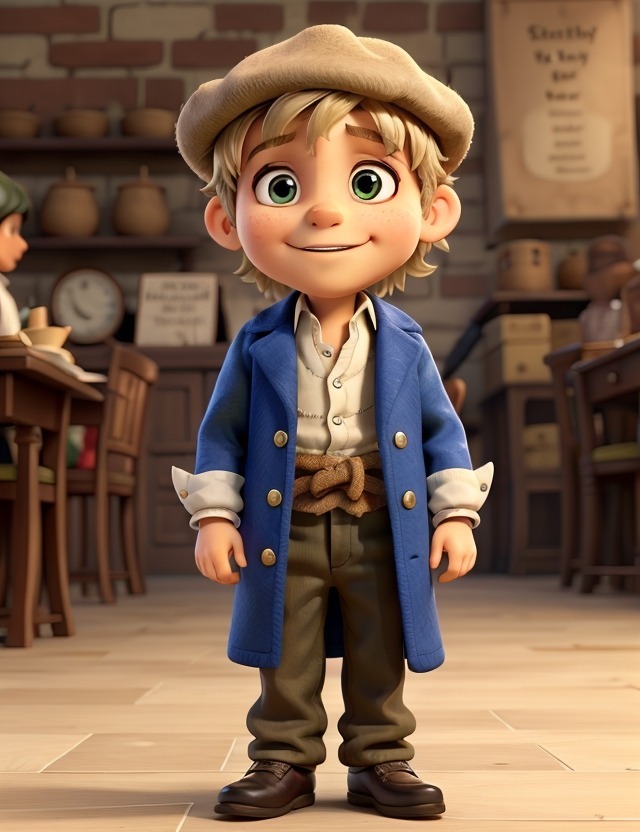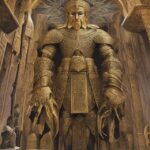In the vast realm of literature, few tales have endured the test of time quite like Charles Dickens‘ classic masterpiece, Oliver Twist. Step into the grim yet captivating world of Victorian London with this iconic novel, as we unravel the enigmatic storyline that has captivated generations of readers. Delve into the heart-wrenching struggle of an orphaned boy, cast amidst the dark underbelly of society, all while navigating the webs of corruption, injustice, and redemption. Brace yourself as we embark on an insightful journey, dissecting the historic backdrop, the author’s intent, and the profound relevance that makes Oliver Twist an eternal literary gem.
From its first publication in 1838 to the present day, Oliver Twist remains an invaluable testament to the state of society during the Industrial Revolution. With its vivid descriptions and memorable characters, Dickens’ eloquent prose unveils a complex narrative that exposes the harsh realities faced by the marginalized and vulnerable. By shedding light on the plight of orphans and the underprivileged, the novel not only serves as a historical document but also explores timeless themes, such as the quest for identity, the pursuit of justice, and the power of compassion.
Join us as we venture into the world Dickens spun through his pen, revitalizing the forgotten corners of history and perpetuating a timeless tale of resilience, redemption, and the indomitable spirit of humanity. Whether you’re a long-time fan of classic literature or a newcomer seeking to discover the marvels it holds, this article will feed your curiosity, satisfy your search intention, and leave you eager to explore Dickens’ mesmerizing Oliver Twist in its entirety.
Oliver Twist: Full Book Summary
Once upon a time, in a small town in England, there lived a young boy named Oliver Twist. Oliver was an orphan, which meant he didn’t have any parents to take care of him. He lived in a workhouse, a place where poor and orphaned children were sent to live and work.
Life at the workhouse was very difficult for Oliver. The children were given very little food and were often treated poorly by the adults. Oliver dreamed of a better life, one where he would have enough to eat and a loving family to take care of him.
One day, Oliver was chosen to ask for more food at dinner. The adults were furious and Mr. Bumble, the beadle of the workhouse, decided to send Oliver away to an undertaker named Mr. Sowerberry. Oliver was scared of what the future held for him, but he had no choice but to go.
At Mr. Sowerberry’s, Oliver was treated even worse than he was at the workhouse. He was constantly belittled and made to do the hardest chores. However, there was one bright spot in his life – a young girl named Charlotte, who worked at the undertaker’s too. She became Oliver’s only friend and they would spend their free time exploring the town together.
One day, while out on their adventures, Oliver encountered a young boy named Jack Dawkins, also known as the Artful Dodger. Jack was part of a gang of child thieves, led by a cunning old man named Fagin. Touched by Oliver’s innocence and charm, Jack invited him to come to their hideout.
Oliver, curious and longing for friendship, followed Jack to Fagin’s hideout. There, he met the other members of the gang – Nancy, a kind-hearted girl, and Bill Sikes, a dangerous and menacing man. Fagin, a sly and manipulative man, saw potential in Oliver and decided to teach him how to pick pockets and steal.
Oliver was torn between his desperate desire for companionship and the realization that stealing was wrong. However, he felt trapped in his situation and decided to go along with Fagin’s plans. As he became more involved in the gang’s activities, Oliver discovered the darker side of the criminal underworld.
One day, while attempting to pick a pocket, Oliver was caught by Mr. Brownlow, a kind and wealthy gentleman. Mr. Brownlow, instead of turning Oliver over to the authorities, took him into his own home. Oliver was overwhelmed by the kindness and generosity shown to him, experiencing the love and care he had always longed for.
Unbeknownst to Oliver, Nancy, who had grown fond of him, secretly betrayed Fagin and Sikes by telling Mr. Brownlow about their plans to kidnap Oliver. This act of courage put Nancy in great danger, as Fagin and Sikes discovered her betrayal. They threatened to harm Nancy if she didn’t return Oliver to them.
Nancy, torn between her loyalty to Fagin and her affection for Oliver, made a difficult decision. She devised a plan to save Oliver and bring him back to Mr. Brownlow, hoping to redeem herself. Unfortunately, Sikes discovered her plan and, in a fit of rage, murdered Nancy.
Meanwhile, back at Mr. Brownlow’s house, Oliver was happily settling into his new life. He had been treated like a member of the family, and Mr. Brownlow had even discovered that Oliver was not an orphan after all. He was indeed the long-lost nephew of Mr. Brownlow’s best friend.
But just as things were starting to look brighter, Oliver’s past caught up with him. Sikes, seeking revenge, kidnapped Oliver and planned to use him in a robbery. However, the police were soon hot on their trail, and Sikes fled in a panic, accidentally hanging himself in the process.
In the end, Oliver was reunited with his loving relatives and found a forever home with Mr. Brownlow. Fagin and most of the gang were captured by the police and brought to justice. It was a happy ending for Oliver, who finally found the family he had always dreamed of.
Oliver Twist is a heartwarming tale of hope, resilience, and the importance of love and kindness. It teaches us that no matter how dark our circumstances may seem, there is always a glimmer of light waiting to guide us to a better future. It reminds us that true family is not always defined by blood, but by the genuine care and support we receive from those who love us. Oliver’s story is a timeless classic that will continue to inspire readers of all ages with its message of compassion and redemption.
Oliver Twist: Key Themes
Oliver Twist, written by Charles Dickens, is a classic novel published in 1839. It tells the story of a young orphan named Oliver Twist, who navigates through the harsh realities of Victorian England. The book shines a light on social injustice, poverty, and the struggles of the working class. Here are three key themes in the book:
1. Social Injustice: Oliver Twist highlights the severe social injustices prevalent in the 19th-century British society. The novel exposes the mistreatment of orphans and the poor, as well as the exploitation of child labor. Oliver, born in a workhouse and raised in a harsh orphanage, faces continuous maltreatment and abuse from those in power. Dickens criticizes the social system that fails to protect vulnerable individuals and instead perpetuates their suffering.
2. Poverty and the Working Class: Poverty is depicted as a pervasive and degrading force in Oliver Twist. The book shows the desperate circumstances of those living in extreme poverty, struggling to survive and often resorting to crime. Dickens exposes the brutal reality of the working class, highlighting their constant hunger, homelessness, and the lack of opportunities. His portrayal of these conditions sheds light on the wider societal issues surrounding poverty and advocates for social change.
3. Redemption and Morality: Despite the bleakness and moral corruption present throughout the book, Oliver Twist ultimately explores the themes of redemption and morality. Oliver, initially seen as a naive and helpless child, encounters a range of individuals – both kind-hearted and morally corrupt. Some characters, such as Nancy and Mr. Brownlow, display compassion and strive to protect Oliver from the adverse world around him. The contrast of good and evil characters emphasizes the possibility of moral growth and the ultimate triumph of morality over vices such as greed and corruption.
Overall, Oliver Twist serves as a social commentary on the injustices of Victorian England. It highlights the importance of addressing social inequalities, condemns the exploitation of the poor, and illustrates the potential for redemption and morality even in the darkest of circumstances.
Oliver Twist: Characters
1. Oliver Twist: The protagonist of the story, Oliver is a young, innocent orphan with a kind heart. Despite facing adversity, he maintains his sense of morality and humility. With his angelic face and big, mournful eyes, Oliver becomes a symbol of resilience and hope.
2. Mr. Bumble: A pompous and self-important man, Mr. Bumble is the parish beadle who oversees the workhouse where Oliver resides. He sports a comically large handlebar mustache and an ever-present scowl on his face, making him a source of amusement for the readers.
3. Fagin: The cunning and manipulative leader of a gang of child pickpockets, Fagin is a wiry old man with a long, hooked nose resembling a vulture. His beady eyes never miss an opportunity for profit, and he is always draped in layers of shabby clothing. Fagin’s sly nature and distinctive appearance make him both intriguing and frightening.
4. The Artful Dodger: Fagin’s right-hand thief, the Artful Dodger is a charismatic and quick-witted boy with a mischievous grin and a twinkle in his eyes. He is known for his impressive ability to pick pockets without getting caught, earning him the admiration and envy of his fellow young thieves.
5. Nancy: A member of Fagin’s gang and also the object of Oliver’s affection, Nancy is a beautiful, streetwise woman. With her fiery red hair and bold, confident demeanor, she captivates everyone she encounters. Although she participates in criminal activities, Nancy possesses a genuine kindness that shines through her tough exterior.
6. Bill Sikes: A violent and brutish criminal, Bill Sikes is Nancy’s abusive boyfriend and an associate of Fagin. Towering in stature with a perpetually scowling face and gnarled hands, he strikes terror into the hearts of others. Bill’s menacing presence and unrestrained anger create an atmosphere of constant unease.
7. Mr. Brownlow: A wealthy gentleman who takes an interest in Oliver, Mr. Brownlow is described as having a gentle face framed by silver-grey hair. He exudes an air of dignity and compassion. With his refined manners and fatherly demeanor, Mr. Brownlow provides a stark contrast to the harshness of Oliver’s previous experiences.
8. Mrs. Sowerberry: The wife of the local undertaker, Mrs. Sowerberry is a thin and gaunt woman with a permanent sour expression. She is notorious for her excessive use of black clothing and her tendency to sigh dramatically whenever she speaks. Mrs. Sowerberry’s exaggerated melancholy adds a touch of dark humor to the story.
9. Noah Claypole: A sniveling and cowardly apprentice to Mrs. Sowerberry, Noah constantly teases and bullies Oliver. He is described as having a perpetually runny nose and an obnoxiously high-pitched voice. Despite his despicable behavior, Noah’s exaggerated mannerisms and comedic traits ensure that readers enjoy his comeuppance.
10. Mr. Fang: A corrupt and cruel magistrate who presides over Oliver’s trial, Mr. Fang epitomizes the epitome of an unscrupulous authority figure. His short stature, greasy black hair, and beady eyes give him an untrustworthy appearance. Mr. Fang’s penchant for unjust rulings and underhanded behavior make him an easy target for satire and ridicule.
Oliver Twist: Symbols
1) The workhouse symbolizes the harsh and oppressive conditions faced by the poor and orphaned children in Charles Dickens’ Oliver Twist. It represents a system that fails to provide for its most vulnerable members, forcing them into a life of poverty and despair. The workhouse also highlights the indifference and cruelty of those in positions of power, who profit from the labor of the impoverished while denying them basic rights and opportunities.
2) The pocket watch is a powerful symbol of time and destiny in Oliver Twist. When Oliver’s mother dies, she clings to a small gold locket and gives birth while staring at it. Later, the same locket is passed down to Oliver. This inherited pocket watch represents the intergenerational cycle of poverty and struggle, as well as the idea that one’s circumstances and destiny can be predetermined by birthright.
3) The river Thames serves as a recurring symbol throughout the book, representing both hope and danger. It is a source of solace for Oliver, as he finds peace and respite while gazing at its majestic flow. However, the river is also associated with various criminal activities and serves as a backdrop for crucial events in the novel, such as the death of Bill Sikes. This duality highlights the contrast between the purity and innocence of Oliver and the corrupting forces of society that surround him. The river Thames thus becomes a symbol of both potential escape and the looming threats that Oliver must face in his journey.
Oliver Twist: Culture Impact
Oliver Twist, written by Charles Dickens in 1838, can be aptly described as a literary classic that had a profound cultural impact on society. This timeless tale of poverty, hardship, and redemption not only captivated readers but also sparked significant social change during the Victorian era.
Historically, Oliver Twist shed light on the harsh realities faced by the lower classes in nineteenth-century England. Through vivid descriptions and compelling characters, Dickens exposed the underbelly of society, revealing the deplorable living conditions, child labor, and rampant criminality that plagued the urban poor. The book created a sensation, as it pulled back the curtain on the grim world often unseen by the upper classes, forcing them to confront the inadequacies of their society.
However, it is not just the historical significance that makes Oliver Twist impactful, but also the humorous touches Dickens infused throughout the narrative. The author’s wit and satirical tone injected levity into an otherwise bleak story, providing readers with moments of laughter amidst the darkness. From the amusing escapades of the lovable rogue, the Artful Dodger, to the comical antics of Mr. Bumble, the pompous and self-important beadle, the book employed humor to engage its audience and prevent them from being overwhelmed by the gloomy subject matter.
Furthermore, Oliver Twist achieved significant achievements in its time. By presenting Oliver, an innocent and vulnerable orphan, as the central character, Dickens successfully evoked sympathy and compassion from readers. The book’s portrayal of Oliver’s endurance in the face of adversity resonated deeply with the Victorian audience, leading to increased awareness and advocacy for societal reform. Such was the influence of Oliver Twist that it played a crucial role in exposing the flaws of the Poor Laws, eventually contributing to the implementation of several reforms aimed at improving the conditions of the impoverished masses.
With its cultural impact, Oliver Twist remains a celebrated literary work that transcends time. It opened the public’s eyes to the rampant social injustices prevailing in Victorian society, reminding them of the importance of empathy and compassion. Through humor and humanity, this novel left an indelible mark on the cultural landscape, not only shaping the perception of poverty and social inequity but also inspiring generations of writers to delve into social criticism through literature. Oliver Twist continues to enrich our understanding of the past and serves as a poignant reminder of the power of literature to instigate change.
FAQs
1. Who wrote the book “Oliver Twist”?
“Oliver Twist” was written by Charles Dickens.
2. What is the story of “Oliver Twist” about?
“Oliver Twist” follows the life of an orphan named Oliver who faces various hardships and mistreatment while growing up. The story explores themes of poverty, crime, and the struggles faced by the lower class in Victorian England.
3. When was “Oliver Twist” first published?
The book was first published in serial form, with chapters appearing in monthly installments from February 1837 to April 1839. It was later published as a complete novel in 1839.
4. Is the book “Oliver Twist” based on a true story?
While “Oliver Twist” is a work of fiction, it is inspired by the author’s own experiences and the social issues prevalent in 19th century England. Charles Dickens witnessed the hardships faced by the poor and incorporated them into the narrative.
5. Are there any adaptations or movies based on “Oliver Twist”?
Yes, “Oliver Twist” has been adapted into numerous films, plays, and musicals over the years. One of the most famous adaptations is the 1968 musical film by Carol Reed titled “Oliver!” which won several Academy Awards, including Best Picture.
6. What is the significance of the title “Oliver Twist”?
The title “Oliver Twist” refers to the main character’s life story, which is full of twists and turns. The word “twist” also has a secondary meaning, which is slang for a child born out of wedlock.
7. What is the role of Fagin in “Oliver Twist”?
Fagin is a criminal who trains young boys to pick pockets and steal for him. He is the leader of a gang of thieves and is responsible for introducing Oliver to a life of crime.
8. What is the relationship between Nancy and Bill Sikes in “Oliver Twist”?
Nancy is a prostitute who is in a relationship with Bill Sikes, a violent criminal. She is torn between her loyalty to Sikes and her desire to help Oliver.
9. What is the significance of the character of Mr. Brownlow in “Oliver Twist”?
Mr. Brownlow is a wealthy gentleman who takes an interest in Oliver and tries to help him. He is one of the few characters in the novel who is genuinely kind and compassionate.
10. What is the significance of the character of Monks in “Oliver Twist”?
Monks is a mysterious figure who is revealed to be Oliver’s half-brother. He is the main antagonist of the novel and is responsible for many of the misfortunes that befall Oliver.










